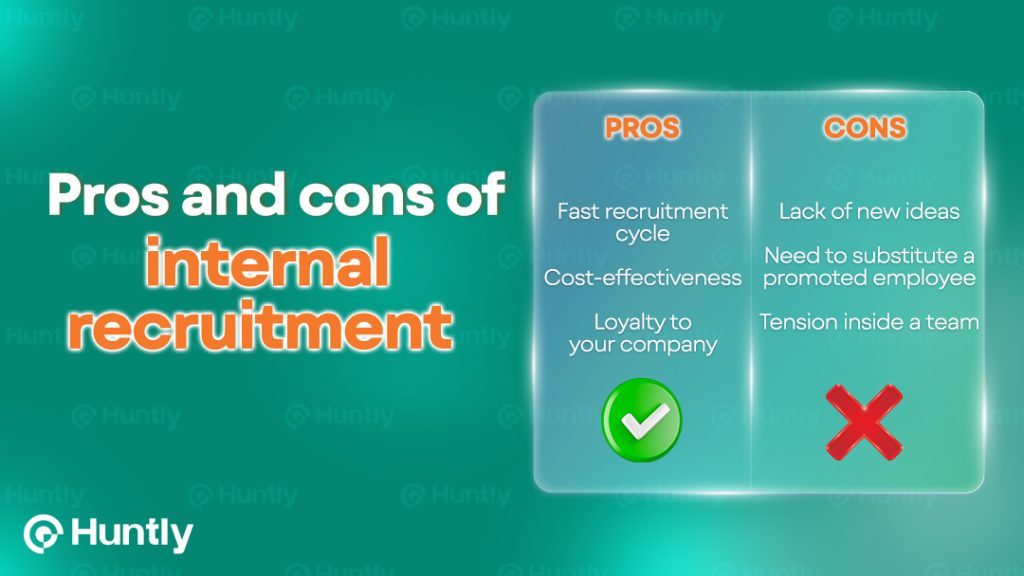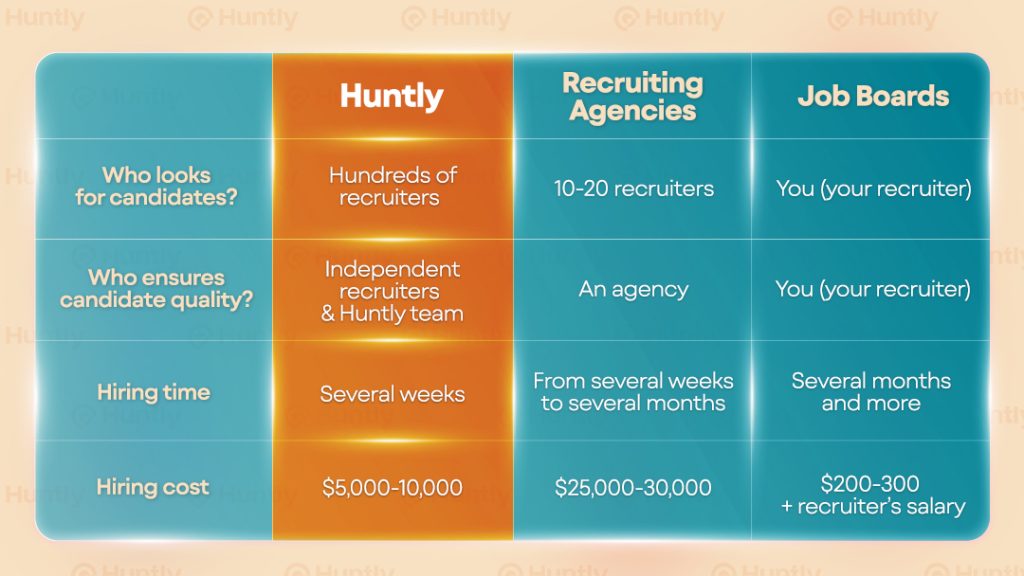Internal and External Recruitment Methods — What’s Best?
In search of a perfect candidate for a new position, you might want to combine different recruitment methods to achieve the best results. One can differentiate two main types of recruitment methods: internal and external.
Internal recruitment methods
Internal recruitment means that you look for a candidate among your current staff. Examples of internal recruitment methods are promotion, full-time transition, and transfer. Promotion means that you fill a new higher role with an employee who has shown outstanding results before and attains all the skills to succeed in the new position. Full-time transition is changing an employee’s terms of cooperation from part-time or contract basis to full-time. Transfer is moving a team member from one department (or location) to another.
All these hire methods have advantages and disadvantages you should know about before using them.
Pros of internal recruitment:
- Fast recruitment and onboarding cycles. Unlike the situations when you hire people outside the company, internal recruitment happens much faster. You already know your employees, their skills and motivations, so you can easily identify who will better fit a new role. At the same time, your employees know company processes, share corporate values and make a perfect cultural fit, so you won’t have to teach them all these things from scratch.
- Cost-effective way to fill a vacancy. As you don’t invest in actual recruitment when promoting or transferring your current coworker from one position to another, you save a lot of the hiring cost.
- Building loyalty to your company among your employees. Financial motivation isn’t the only thing that interests modern employees. True professionals are interested in self-development, so the more growth opportunities you provide inside your company, the more satisfaction and loyalty you can expect from your team.
Cons of internal recruitment:
- Lack of new ideas for company development. While not always the case, such a course of events can happen. People who work for one company or project for a long time might lose track of industry trends. They may focus on their current tasks so much that they stop thinking out of the box. No doubt, that’s a very important skill in a highly competitive business environment.
- Need to fill the position of a promoted/transferred team member. When you use internal employee recruitment methods, you will still have to fill the position of a promoted/transferred person, so you don’t completely get rid of the necessity to hire new people.
- Tension among team members. There can be several candidates for promotion, so unhealthy competition might appear within the team. Those employees who didn’t succeed in advancement might get frustrated and lose motivation.

External recruitment methods
External recruitment methods mean you hire new team members outside the company. External methods of hiring include engaging recruitment vendors, using job boards, or attending recruitment events, etc.
Pros of external recruitment:
- Big talent pool. Unlike internal approaches to recruitment, external methods offer the possibility to tap into previously undiscovered pools of candidates with diverse experiences and skills. Thus, you have a chance of finding an expert your company lacks.
- Fresh ideas and innovation. People who join your company from the outside can often look at your business from a new perspective and give you valuable insights on how to achieve your business goals.
- Expertise in a particular field. In case you don’t have time to teach your existing employees and need a professional with specific knowledge or experience in a certain field, hiring a completely new person is a sensible decision in terms of the time and effort you’ll spend.
Cons of external recruitment:
- Additional cost. Whether you have a recruitment department in your company or outside it, you pay extra money for human work, time, and services you use.
- Time-consuming process. Finding a perfect match for an open position externally can take months, which is OK if you have the time and money for that. However, it could become a problem in times of seasonal business spikes and limited budgets. You should be ready for this if you choose traditional external recruitment styles.

In case you have a difficult tech vacancy and would like to try innovative ways of recruiting that can bring you the desired result faster and cheaper, Huntly is here to help! With our community-based approach, you get a number of advantages. The reach of your vacancy is guaranteed by the robust network of tech recruiters, the price is defined by you, and quality is ensured by our thorough pre-screening. Huntly takes on the vetting part by asking referred candidates hard interviews questions to forward only the most relevant tech talents to you. As a result, 4 out of 5 of our candidates are invited for the client’s interview.
9 Best Methods of Recruitment in Tech
Before we dive into different methods of recruitment, it’s important to understand one thing that will help you find the best tech professionals no matter what approaches you use. As a preparatory part, you should create a clear job description, with all the requirements and details, where you’ll answer potential questions of candidates beforehand. A clear job description will help you speed up the hiring process by filtering out the candidates who don’t have the necessary skills or don’t agree to the terms you point out in the vacancy.
Once you have the perfect job description, you can start thinking about the recruitment methodologies to fill an existing vacancy.
1. Employ social media
LinkedIn, the most world-renowned professional social media, has more than 1 billion users. Using LinkedIn with its great community and focus on professional development is one of the most common recruitment techniques. You can also use Facebook or Twitter to announce that you’re hiring — the more people know about your open position, the more potential candidates you can expect. However, as job seekers apply without any pre-vetting through social media, you’ll have to check every CV on your own.
2. Organize external apprenticeships
While this hiring method will take you some time and effort, it will also give you a chance to attract and grow professionals who will become a perfect match for your company. During several months of apprenticeship you’ll be able to spot the most talented young specialists for hire.
3. Leverage passive recruitment
It might happen that your perfect candidate works for another company, and this is where you can try passive recruitment. Passive candidates are the ones who aren’t looking for a job at the moment but they might perfectly suit your open position. If you're ready for such a long run, try to reach them out on social media and via email to build a rapport first. But if you manage to contact them at the right time, they might consider your offer.
4. Expand your network as a way of recruiting
Networking is one of the most effective recruitment techniques from a strategic perspective. You can build connections with tech professionals in your industry by visiting local recruitment events or taking part in web conferences. This is a great way to tell potential candidates about your company and build brand awareness. As a result, you might find new ways to scale your business from hiring tech talents remotely to outsourcing in Latin America, Eastern Europe, or anywhere in the world.
5. Leverage word of mouth
This can be one of the easiest ways of recruiting employees for big corporations. If you have a great employer brand and know that a lot of people would like to join your company, posting an open position on your website might be enough to attract quality IT specialists.
6. Use AI
Artificial intelligence is not a novelty in our everyday duties, and AI in recruitment process isn’t an exception. Today, software based on artificial intelligence can help you verify CVs faster or match active candidates to your open positions.
7. Run referral programs
One can divide referral programs into two types — internal and external — and both of them are effective ways of recruiting staff.
Internal referrals mean that you ask your current employees to refer their friends and acquaintances to your open position. Applying internal referrals is a win-win because:
- your employees have a good understanding of processes and responsibilities, so they are likely to identify strong candidates to suit an open position;
- your employees promote your company’s brand by inviting people to join your company;
- your employees are motivated to help recruiters fill a vacancy because they get a bonus for a successful referral.
Another type is external referrals, and they also have a great potential to help you find suitable tech professionals. For example, Huntly belongs to the innovative type of recruitment methods that can increase your pipeline of relevant candidates by allowing a global community of recruiters to refer candidates to your open positions.
What sets our solution apart from internal referrals is that we ensure the relevance and quality of the referred specialists with the two layers of pre-screening. The first step is recommendations from professional recruiters who have experience in IT hiring and have a knack for identifying top talent. The second step is pre-vetting done by the Huntly team to filter out candidates who might not satisfy the requirements of your position.
For example, if you want to expand to LATAM but don’t have recruitment resources in tech hubs of Latin America, Huntly can provide you with the list of relevant local tech specialists within 72 hours.
8. Utilize online job boards
One of the oldest but still viable recruitment approaches, online job boards give you access to a pool of active and passive candidates who might suit your vacancy. While you do have a great choice of candidates on job boards, this method has its flaws such as loads of CVs you’ll have to verify manually before you can invite a person to the first interview. Thus, you are likely to spend a lot of time before you find a really worthy candidate.
9. Collaborate with recruitment agencies
Recruitment agencies serve as mediators between employers and candidates and are responsible for the biggest part of the hiring process. However, while saving your time, agencies charge huge fees and upfront payments. Plus, it will be your responsibility to check if a candidate provided by the agency fits your corporate culture, so you can’t delegate the hiring process completely. Finally, recruitment agencies don’t usually reflect your company brand, thus could make some good candidates hesitant from applying.
How to Choose the Most Effective Recruitment Techniques?
It may be hard to identify the best way of recruitment for your business because different situations require differing approaches. Consequently, to achieve the most effective results when hiring new people you should show some creativity and combine various methods of recruitment.
That’s exactly what Huntly is about. We steer clear of the traditional IT talent market by combining advantages of recruitment agencies, referral programs, and job boards (while eliminating their flaws). Our innovative vision of tech recruitment can become a game-changer for you. So if the conventional types of hiring processes didn’t work out, try out Huntly! Below, you can see how we differ from them.









